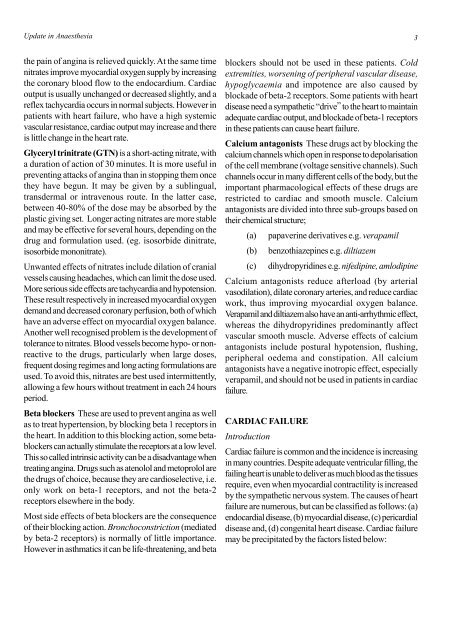Download Update 11 - Update in Anaesthesia - WFSA
Download Update 11 - Update in Anaesthesia - WFSA
Download Update 11 - Update in Anaesthesia - WFSA
You also want an ePaper? Increase the reach of your titles
YUMPU automatically turns print PDFs into web optimized ePapers that Google loves.
<strong>Update</strong> <strong>in</strong> <strong>Anaesthesia</strong> 3the pa<strong>in</strong> of ang<strong>in</strong>a is relieved quickly. At the same timenitrates improve myocardial oxygen supply by <strong>in</strong>creas<strong>in</strong>gthe coronary blood flow to the endocardium. Cardiacoutput is usually unchanged or decreased slightly, and areflex tachycardia occurs <strong>in</strong> normal subjects. However <strong>in</strong>patients with heart failure, who have a high systemicvascular resistance, cardiac output may <strong>in</strong>crease and thereis little change <strong>in</strong> the heart rate.Glyceryl tr<strong>in</strong>itrate (GTN) is a short-act<strong>in</strong>g nitrate, witha duration of action of 30 m<strong>in</strong>utes. It is more useful <strong>in</strong>prevent<strong>in</strong>g attacks of ang<strong>in</strong>a than <strong>in</strong> stopp<strong>in</strong>g them oncethey have begun. It may be given by a subl<strong>in</strong>gual,transdermal or <strong>in</strong>travenous route. In the latter case,between 40-80% of the dose may be absorbed by theplastic giv<strong>in</strong>g set. Longer act<strong>in</strong>g nitrates are more stableand may be effective for several hours, depend<strong>in</strong>g on thedrug and formulation used. (eg. isosorbide d<strong>in</strong>itrate,isosorbide mononitrate).Unwanted effects of nitrates <strong>in</strong>clude dilation of cranialvessels caus<strong>in</strong>g headaches, which can limit the dose used.More serious side effects are tachycardia and hypotension.These result respectively <strong>in</strong> <strong>in</strong>creased myocardial oxygendemand and decreased coronary perfusion, both of whichhave an adverse effect on myocardial oxygen balance.Another well recognised problem is the development oftolerance to nitrates. Blood vessels become hypo- or nonreactiveto the drugs, particularly when large doses,frequent dos<strong>in</strong>g regimes and long act<strong>in</strong>g formulations areused. To avoid this, nitrates are best used <strong>in</strong>termittently,allow<strong>in</strong>g a few hours without treatment <strong>in</strong> each 24 hoursperiod.Beta blockers These are used to prevent ang<strong>in</strong>a as wellas to treat hypertension, by block<strong>in</strong>g beta 1 receptors <strong>in</strong>the heart. In addition to this block<strong>in</strong>g action, some betablockerscan actually stimulate the receptors at a low level.This so called <strong>in</strong>tr<strong>in</strong>sic activity can be a disadvantage whentreat<strong>in</strong>g ang<strong>in</strong>a. Drugs such as atenolol and metoprolol arethe drugs of choice, because they are cardioselective, i.e.only work on beta-1 receptors, and not the beta-2receptors elsewhere <strong>in</strong> the body.Most side effects of beta blockers are the consequenceof their block<strong>in</strong>g action. Bronchoconstriction (mediatedby beta-2 receptors) is normally of little importance.However <strong>in</strong> asthmatics it can be life-threaten<strong>in</strong>g, and betablockers should not be used <strong>in</strong> these patients. Coldextremities, worsen<strong>in</strong>g of peripheral vascular disease,hypoglycaemia and impotence are also caused byblockade of beta-2 receptors. Some patients with heartdisease need a sympathetic “drive” to the heart to ma<strong>in</strong>ta<strong>in</strong>adequate cardiac output, and blockade of beta-1 receptors<strong>in</strong> these patients can cause heart failure.Calcium antagonists These drugs act by block<strong>in</strong>g thecalcium channels which open <strong>in</strong> response to depolarisationof the cell membrane (voltage sensitive channels). Suchchannels occur <strong>in</strong> many different cells of the body, but theimportant pharmacological effects of these drugs arerestricted to cardiac and smooth muscle. Calciumantagonists are divided <strong>in</strong>to three sub-groups based ontheir chemical structure;(a) papaver<strong>in</strong>e derivatives e.g. verapamil(b) benzothiazep<strong>in</strong>es e.g. diltiazem(c) dihydropyrid<strong>in</strong>es e.g. nifedip<strong>in</strong>e, amlodip<strong>in</strong>eCalcium antagonists reduce afterload (by arterialvasodilation), dilate coronary arteries, and reduce cardiacwork, thus improv<strong>in</strong>g myocardial oxygen balance.Verapamil and diltiazem also have an anti-arrhythmic effect,whereas the dihydropyrid<strong>in</strong>es predom<strong>in</strong>antly affectvascular smooth muscle. Adverse effects of calciumantagonists <strong>in</strong>clude postural hypotension, flush<strong>in</strong>g,peripheral oedema and constipation. All calciumantagonists have a negative <strong>in</strong>otropic effect, especiallyverapamil, and should not be used <strong>in</strong> patients <strong>in</strong> cardiacfailure.CARDIAC FAILUREIntroductionCardiac failure is common and the <strong>in</strong>cidence is <strong>in</strong>creas<strong>in</strong>g<strong>in</strong> many countries. Despite adequate ventricular fill<strong>in</strong>g, thefail<strong>in</strong>g heart is unable to deliver as much blood as the tissuesrequire, even when myocardial contractility is <strong>in</strong>creasedby the sympathetic nervous system. The causes of heartfailure are numerous, but can be classified as follows: (a)endocardial disease, (b) myocardial disease, (c) pericardialdisease and, (d) congenital heart disease. Cardiac failuremay be precipitated by the factors listed below:
















